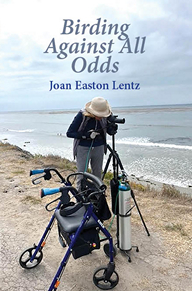A DAY AT COAL OIL POINT WITH THE BIRDING CLASS
MARCH 5, 2014:
Today a group of us walked from Isla Vista along the bluffs to Coal Oil Point, Devereux Slough, and back.
It was a perfect day for birding, with gray skies and no wind.
At our first stop, we looked down on Isla Vista beach. It was low tide and there were few shorebirds.
Big waves came rolling in. Surfers and paddleboarders were the main attraction.
“There’s nothing here.” Hmmm…
Well, let’s set up the scopes and scan the ocean and see what’s going on.
So we began to study the situation.
On the floating kelp beds, a Great Egret and a couple of Snowy Egrets walked around. We could see them through the scopes, and then we spotted a pair of Mallards, of all things — way out there dabbling away.
Common Dolphins churned the water beyond. Surf Scoters and Brandt’s Cormorants came and went, their dark forms scudding just above the surface of the breaking waves.
A mystery bird: Dennis Ringer asked me to come have a look. Wow! A Common Murre preening just beyond the surf line. Its black head, thick bill, and white underparts were diagnostic. Murres aren’t often seen from shore along the south coast.
So, that was really exciting!
Down on the wet sand, large flocks of Marbled Godwits and Willets appeared to probe for morsels beneath the surface. Suprisingly, no Sanderlings today.
We walked on along the bluffs, loving the mud and the puddles after our recent rainstorm. Western Meadowlarks and Red-winged Blackbirds foraged in the wet grass.
At Coal Oil Point, the rocks held California Gulls and Heermann’s Gulls, along with a few Western Gulls and 11 Royal Terns. It was exciting at the Point, with the Gray Whales Count group censusing the whale migration and the low tide revealing the tidepools below us. I was surprised to see no turnstones on the dark rocks.
At Sands Beach, the effects of the storm were evident: the dunes where the Snowy Plovers nest were eaten away by the huge waves. High tide had breeched the sand bar blocking Devereux Slough. A thin channel of water streamed out to sea between the sandy banks.
What a difference a week makes. Last week, we’d looked east from Ellwood Mesa and seen a wide, stable band of dunes. But high tide and storm surge had sculpted and changed the landscape. I love this unpredictability.
At the slough itself, it was as though a large lake had been quickly drained. Dried algae hung from the edges of the salicornia marsh. Huge pieces of kelp had been washed in and lay floating on the shallow water. The water was low enough to support shorebirds and some ducks, although many ducks had left for other watery areas after the storm.
Green-winged Teal and Northern Shovelers hugged the margins of the slough. A beautiful Northern Pintail stood out from the crowds of Ruddy Ducks.
This is really shorebird habitat now. A huge flock of Semipalmated Plovers flew in. I wouldn’t be surprised if way over on the northern shore we’d have seen some Snowy Plovers, but they were too far away to i.d. A Greater Yellowlegs and a Black-necked Stilt foraged beside a couple of Least Sandpipers.
From time to time, we heard the high, thin song of a Belding’s Savannah Sparrow, when it T’d up on a sprig of pickleweed to stake out a spring territory.
As we made our way back through the West Campus, somebody in the class spotted an adult male Hooded Oriole.
What a great mix of passerines and waterbirds on this trip — over 60 species.
Here’s a complete list:
Canada Goose – 2 (fo)
Gadwall – 2
American Wigeon – 12
Mallard – X (noted a pair feeding in kelp beds)
Northern Shoveler – 15
Northern Pintail – 2
Green-winged Teal – 8
Surf Scoter – 3 (fo)
Bufflehead – 1
Red-breasted Merganser – 1
Ruddy Duck – 30
Eared Grebe – 2
Brown Pelican – X
Brandt’s Cormorant – 6
Double-crested Cormorant – 1
Great Blue Heron – 3
Great Egret – 4
Snowy Egret – 2
Black-crowned Night-Heron – 2
Turkey Vulture – 4
White-tailed Kite – 1 (fo)
Red-tailed Hawk – 3
American Coot – 2
Black-bellied Plover – 25
Semipalmated Plover – ~100
Killdeer – 8
Black-necked Stilt – 1
Greater Yellowlegs – 1
Willet – 20
Whimbrel – 4
Long-billed Curlew – 1
Marbled Godwit – 40
Least Sandpiper – 2
Heermann’s Gull – 15
Ring-billed Gull – 4
California Gull – 35
Western Gull – 15
Royal Tern – 11
*Common Murre – 1
Eurasian Collared-Dove – 1
Anna’s Hummingbird – 1
Selasphorus – 1
Black Phoebe – 2
Cassin’s Kingbird – 1
American Crow – X
Bushtit – 12-15
Bewick’s Wren – 5
Marsh Wren – 1 (heard)
Ruby-crowned Kinglet – 1 (heard)
Western Bluebird – 2 (at nest box)
Wrentit – 1 (heard)
Cedar Waxwing – 8 (at very end of class)
Townsend’s Warbler – 1
Common Yellowthroat – 1 (heard)
California Towhee – 8
(Belding’s) Savannah Sparrow -2 (heard)
Song Sparrow – 10
White-crowned Sparrow and Golden-crowned Sparrow – X (several on ground near bluebird box but never counted)
Red-winged Blackbird – ~50 in a flock on the bluffs
Western Meadowlark – 10
Hooded Oriole – 2
Purple Finch – 2 (heard)
House Finch – ~5
fo = fly over
X = seen but not censused
Note: numbers are estimates only

